Content for TS 23.282 Word version: 19.5.0
1…
5…
6…
6.6…
7…
7.4…
7.4.2.7…
7.4.3…
7.5…
7.5.2.5…
7.5.2.10…
7.5.3…
7.6…
7.7…
7.8…
7.9…
7.13…
7.13.3.14…
7.13.4…
7.14…
7.17…
7.17.3.1.4…
7.17.3.2…
7.17.3.2.5…
7.17.4…
7.17.6…
A…
B…
7.5.2.5 One-to-one file distribution using media plane
7.5.2.6 Group standalone file distribution using HTTP
7.5.2.7 Group standalone file distribution using media plane
7.5.2.8 File removal using HTTP by authorized user
...
...
7.5.2.5 One-to-one file distribution using media plane p. 121
7.5.2.5.1 General p. 121
The MCData client uses the media plane for a standalone data file download from another MCData client. The procedure is appropriate for both mandatory and non-mandatory download cases. The target MCData user may be addressed using the functional alias that can be shared with other MCData users.
7.5.2.5.2 Procedure p. 121
The procedure in Figure 7.5.2.5.2-1 describes the case where an MCData user is initiating one-to-one data communication for sending file to the other MCData user, with or without download completed report request.
Pre-conditions:
- The MCData users on the MCData client 1 and the MCData client 2 are already registered for receiving MCData service.
- Optionally, the MCData client may have an activated functional alias to be used.
- The MCData server has subscribed to the MCData functional alias controlling server within the MC system for functional alias activation/de-activation updates.
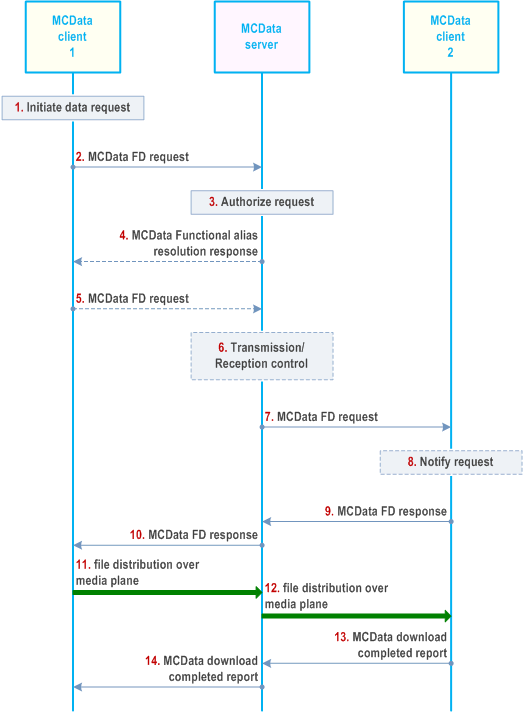
Step 1.
The user at the MCData client 1 initiates a file distribution request to the chosen MCData user.
Step 2.
MCData client 1 sends a MCData FD request towards the MCData server. File metadata information is included in the SDP. The MCData FD request contains one MCData user for one-to-one data communication as selected by the user at MCData client 1. The MCData FD request contains conversation identifier for message thread indication. The MCData FD request may include additional implementation specific information in the application metadata container. MCData FD request may contain mandatory download indication. The MCData FD request may contain download completed report indication if selected by the user at MCData client 1. MCData user at MCData client 1 may include a functional alias within the FD data transfer and may address the target MCData client 2 using a functional alias.
Step 3.
-
If the MCData user at the MCData client 1 initiates an MCData emergency file distribution communication or MCData emergency state is already set for the MCData client 1 (due to previously triggered MCData emergency alert):
- The MCData FD request shall contain emergency indicator; and
- If MCData emergency state is not set already, MCData client 1 sets its MCData emergency state. The MCData emergency state of MCData client 1 is retained until explicitly cancelled by the user of MCData client 1.
MCData server checks whether the MCData user at MCData client 1 is authorized to send MCData FD request. MCData server verifies whether the provided functional alias of MCData client 1, if present, can be used and has been activated for the user. If functional alias is used to address that target MCData user, the MCData server resolves the functional alias to the corresponding MCData ID(s) for which the functional alias is active and proceed with step 4 otherwise proceed with step 6.
Step 4.
The MCData server responds back to MCData client 1 with a functional alias resolution response message that contains the resolved MCData ID.
Step 5.
If the MCData server replies with a MCData functional alias resolution response message, the MCData client 1 assumes the MCData FD request in step 2 is rejected and sends a new MCData FD request towards the resolved MCData ID.
Step 6.
The MCData server also applies transmission and reception control and the necessary policy to ensure that appropriate data is transmitted between the MCData UEs.
Step 7.
MCData server initiates the MCData FD request towards the MCData users determined. The MCData FD request towards the MCData user contains the emergency indicator if it is present in the received MCData FD request from MCData client 1.
Step 8.
The receiving MCData client 2 notifies the user about the incoming MCData FD request which may be either accepted or rejected or ignored. If the request includes mandatory download indication in the MCData FD request an accepted response is assumed.
Step 9.
If the target MCData user 2 provides a response (accept or reject) to the notification, then MCData client 2 sends the MCData FD response to the MCData server. MCData client 2 automatically sends accepted MCData FD response when the incoming request included mandatory download indication.
Step 10.
MCData server forwards the MCData FD response from MCData client 2 back to MCData client 1.
Step 11.
MCData client 1 distributes the file over the established media plane to MCData server.
Step 12.
MCData server distributes the file received from MCData client 1 to MCData client 2 over the established media plane. File download report is shared by the MCData client 2, if requested by the user at MCData client 1. After file transaction is completed, the media plane is released. The MCData client 2 records file download completed and notifies MCData user 2.
Step 13.
MCData client 2 initiates a MCData download completed report for reporting file download completed, if requested by the user at MCData client 1.
Step 14.
The MCData file download completed report from MCData client may be stored by the MCData server for download history interrogation from the authorized MCData users. MCData download completed report is sent by the MCData server to the user at MCData client 1.
7.5.2.6 Group standalone file distribution using HTTP p. 123
7.5.2.6.1 General p. 123
The initiation of a group standalone FD using HTTP to a selected group, results in affiliated group members receiving the file data.
7.5.2.6.2 Procedure p. 123
The procedure in Figure 7.5.2.6.2-1 describes the case where a MCData user is initiating group standalone data communication for sending a file to multiple MCData users, with or without download completed report request from the MCData user.
Pre-conditions:
- The MCData users on the MCData clients 1 to n belong to the same MCData group and are already registered for receiving MCData service and affiliated to the group.
- The file to be distributed is uploaded to the media storage function on the MCData content server using the procedures defined in subclause 7.5.2.2.
- The MCData client may have an activated functional alias to be used.
- The MCData server has subscribed to the MCData functional alias controlling server within the MC system for functional alias activation/de-activation updates.
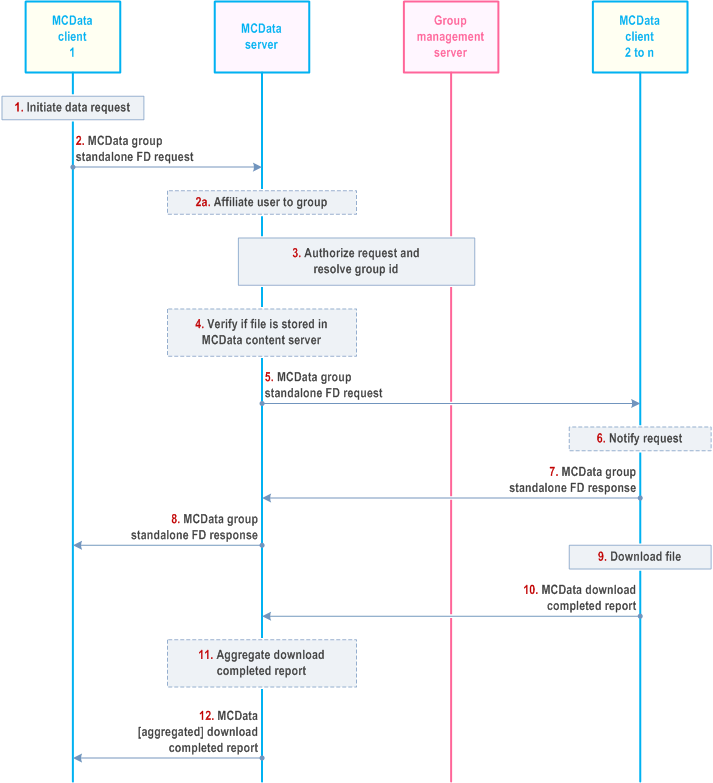
Step 1.
The user at the MCData client 1 initiates a file distribution request to multiple MCData users selecting a pre-configured group (identified by MCData group ID) and optionally particular members from that group.
Step 2.
The MCData client 1 sends a MCData group standalone FD request towards the MCData server. The MCData FD request contains content payload in the form of file URL and may contain the file metadata information. The MCData group standalone data request contains either the selected MCData group ID or the target recipients as selected by the user at MCData client 1. The MCData group standalone FD request contains conversation identifier for message thread indication. The MCData group standalone FD request may include additional implementation specific information in the application metadata container. If MCData user at MCData client 1 has requested to mandatory download at the recipient side, then MCData group standalone FD request contains mandatory download indication. The MCData group standalone FD request may contain a download completed report indication if selected by the user at MCData client 1. The MCData user at MCData client 1 may include a functional alias within the FD data transfer. If the MCData user at MCData client has requested to deposit the file content into his/her MCData message store account, then MCData FD request contains deposit file indication set.
If the MCData user at MCData client 1 initiates an MCData emergency FD communication or the MCData emergency state is already set for the MCData client 1 (due to a previously triggered MCData emergency alert):
Step 2a.
- the MCData group standalone FD request shall contain an emergency indicator;
- the MCData group standalone FD request shall set an alert indicator if configured to send an MCData emergency alert while initiating an MCData group standalone FD request for the emergency FD communication; and
- if the MCData emergency state is not set already, MCData client 1 sets its MCData emergency state. The MCData emergency state of MCData client 1 is retained until explicitly cancelled by the user of MCData client 1.
- the MCData group standalone FD request shall contain an imminent peril indicator.
If either emergency indicator or imminent peril indicator is present in the received MCData group standalone FD request, the MCData server implicitly affiliates MCData client 1 to the MCData group if the client is not already affiliated.
Step 3.
MCData server checks whether the MCData user at MCData client 1 is authorized to send an MCData group standalone FD request and that the size of the file is below maximum data size for FD from the group configuration. MCData server verifies whether the provided functional alias, if present, can be used and has been activated for the user. If the MCData group ID is used, the MCData server resolves the MCData group ID to determine the members of that group and their affiliation status, based on the information from the group management server.
Step 4.
- If an emergency indicator is present in the received MCData group standalone FD request and if the MCData group is not in the in-progress emergency state, the MCData group is considered to be in the in-progress emergency state until cancelled; and
- If an imminent peril indicator is present in the received MCData group standalone FD request and if the MCData group is not in the in-progress imminent peril state, the MCData group is considered to be in the in-progress imminent peril state until cancelled.
The MCData server may verify whether the corresponding file is available in the MCData content server (not shown in the figure) via the MCData-FD-5 reference point using the received file URL in the MCData group standalone FD request. For that, the MCData server sends an MCData file availability request to the MCData content server. Upon the receipt of the request, the MCData content server provides an MCData file availability response to the MCData server. If the MCData server identifies that the file is not available in the MCData content server, the MCData server provides a response to the MCData client 1 indicating that the file distribution request cannot proceed due to the unavailability of the file in the MCData content server and skip rest of the steps. If the deposit file indication information element is set to true in the received MCData FD request, MCData server shall follow the procedure as defined in the subclause 7.13.3.8 with the retrieve file indication element set to true while depositing this MCData communication to the MCData message store account of the user at MCData client 1.
Step 5.
MCData server initiates the MCData group standalone FD request towards each MCData user determined in step 3. The MCData group standalone FD request towards each MCData client contains:
Step 6.
- an emergency indicator if it is present in the received MCData group standalone FD request from the MCData client 1;
- an imminent peril indicator if it is present in the received MCData group standalone FD request from the MCData client 1; and
- an alert indicator if requested to initiate an emergency alert in the received MCData group standalone FD request from the MCData client 1.
The receiving MCData clients 2 to n notify the user about the incoming MCData group standalone FD request (including file metadata, if present) which may be either accepted or rejected or ignored.
Step 7.
If the target MCData user on MCData clients 2 to n provides a response (accept or reject) to the notification, then respective MCData client sends the MCData group standalone FD response to the MCData server. MCData client 2 to n automatically sends accepted MCData group standalone FD response when the incoming request included mandatory download indication.
Step 8.
The MCData server forwards the MCData group standalone FD responses to the MCData client 1.
Step 9.
The media storage client on the MCData client(s) accepting the request downloads the file from the MCData content server (not shown in the figure) using the procedures defined in subclause 7.5.2.3, either automatically (for mandatory download) or based upon the MCData user subsequent action. The MCData clients successfully receiving the file through the media storage clients, record file download completed and notify the MCData users.
Step 10.
The MCData clients, receiving the file through the media storage client, provide MCData download completed reports for reporting file download completed, if requested by the user at MCData client 1.
Step 11.
The MCData file download completed reports from MCData clients may be stored by the MCData server for download history interrogation from the authorized MCData users. The MCData file download completed report from each MCData user may be aggregated.
Step 12.
Aggregated or individual MCData download completed reports are sent by the MCData server to the MCData user at MCData client 1, if requested by the MCData client 1.
7.5.2.7 Group standalone file distribution using media plane p. 126
7.5.2.7.1 General p. 126
The initiation of a group standalone FD using media plane to a selected group, results in affiliated group members receiving the file data.
7.5.2.7.2 Procedure p. 126
The procedure in Figure 7.5.2.7.2-1 describes the case where an MCData user is initiating group standalone data communication for sending file to multiple MCData users, with or without download completed report request.
Pre-conditions:
- The MCData users on the MCData client 1 to n belong to the same group and are already registered for receiving MCData service and affiliated.
- Optionally, the MCData client may have an activated functional alias to be used.
- The MCData server has subscribed to the MCData functional alias controlling server within the MC system for functional alias activation/de-activation updates.
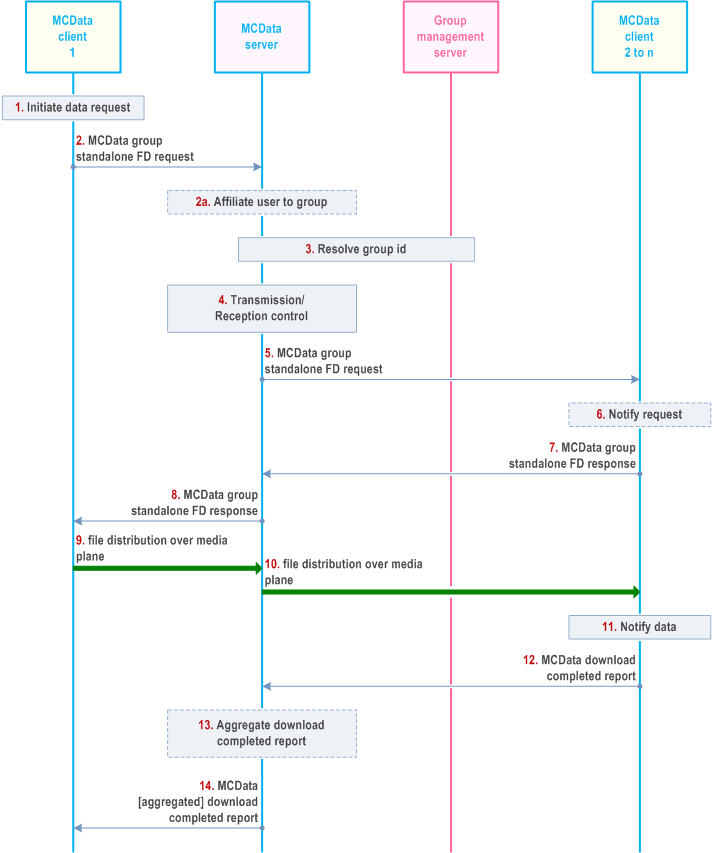
Step 1.
The user at the MCData client 1 initiates a file distribution request to multiple MCData users selecting a pre-configured group (identified by MCData group ID) and optionally particular members from that group.
Step 2.
MCData client 1 sends a MCData group standalone FD request towards the MCData server. File metadata information is included in the SDP. The MCData group standalone data request contains target recipient(s) as selected by the user at MCData client 1. The MCData group standalone FD request contains conversation identifier for message thread indication. The MCData group standalone FD request may include additional implementation specific information in the application metadata container. MCData group standalone FD request may contain mandatory download indication. The MCData group standalone FD request may contain download completed report indication if selected by the user at MCData client 1. MCData user at MCData client 1 may include a functional alias within the FD data transfer.
If the MCData user at MCData client 1 initiates an MCData emergency file distribution communication or the MCData emergency state is already set for the MCData client 1 (due to a previously triggered MCData emergency alert):
Step 2a.
- the MCData group standalone FD request shall contain an emergency indicator;
- the MCData group standalone FD request shall set an alert indicator if configured to send an MCData emergency alert while initiating an MCData group standalone FD request for the emergency file distribution service communication; and
- if the MCData emergency state is not set already, MCData client 1 sets its MCData emergency state. The MCData emergency state is retained until explicitly cancelled.
- the MCData group standalone FD request shall contain an imminent peril indicator.
If either emergency indicator or imminent peril indicator is present in the received MCData group standalone data request, the MCData server implicitly affiliates MCData client 1 to the MCData group if the client is not already affiliated.
Step 3.
MCData server checks whether the MCData user at MCData client 1 is authorized to send MCData group standalone FD request. MCData server verifies whether the provided functional alias, if present, can be used and has been activated for the user. The MCData server resolves the MCData group ID to determine the members of that group and their affiliation status, based on the information from the group management server.
Step 4.
- If an emergency indicator is present in the received MCData group standalone FD request and if the MCData group is not in the in-progress emergency state, the MCData group is considered to be in the in-progress emergency state until cancelled; and
- If an imminent peril indicator is present in the received MCData group standalone FD request and if the MCData group is not in the in-progress imminent peril state, the MCData group is considered to be in the in-progress imminent peril state until cancelled.
The MCData server also applies transmission and reception control and the necessary policy to ensure that appropriate data is transmitted between the MCData UEs.
Step 5.
MCData server initiates the MCData group standalone FD request towards each MCData user determined in step 3. The MCData group standalone data request towards each MCData client contains:
Step 6.
- an emergency indicator if it is present in the received MCData group standalone FD request from the MCData client 1;
- an imminent peril indicator if it is present in the received MCData group standalone FD request from the MCData client 1; and
- an alert indicator if requested to initiate an emergency alert in the received MCData group standalone FD request from the MCData client 1.
The receiving MCData clients 2 to n notifies the user about the incoming MCData group standalone FD request which may be either accepted or rejected or ignored. If the request includes mandatory download indication in the MCData group standalone FD request an accepted response is assumed.
Step 7.
If the target MCData user on MCData clients 2 to n provides a response (accept or reject) to the notification, then the respective MCData client sends the MCData group standalone FD response to the MCData server. MCData client 2 to n automatically sends accepted MCData group standalone FD response when the incoming request included mandatory download indication.
Step 8.
MCData server forwards the MCData group standalone FD response to the MCData client 1.
Step 9.
MCData client 1 and MCData server have successfully established media plane for file transmission and the MCData client 1 transmits the file data.
Step 10.
MCData server distributes the file received from MCData client 1 to MCData clients 2 to n over the established media plane. Distribution of file can be via unicast or via MBMS bearer(s). For distribution via MBMS bearer(s), the procedure described in subclause 7.3 Use of MBMS transmission (on-network) is executed. File download report is shared by the receiving MCData clients, if requested by the user at MCData client 1. After file transaction is completed, the media plane is released.
Step 11.
The MCData clients successfully receiving the file, records file download completed and notifies MCData user.
Step 12.
MCData client 2 initiates a MCData download completed report for reporting file download completed, if requested by the user at MCData client 1.
Step 13.
The MCData file download completed report(s) from MCData client(s) may be stored by the MCData server for download history interrogation from the authorized MCData users. The MCData file download completed report from each MCData user may be aggregated.
Step 14.
Aggregated or individual MCData file download completed report is sent to the disposition requesting user at MCData client 1.
7.5.2.8 File removal using HTTP by authorized user |R16| p. 129
7.5.2.8.1 General p. 129
The media storage client uses HTTP to remove a file that was previously uploaded to the MCData content server.
7.5.2.8.2 Procedure for single MCData system p. 129
The procedure in Figure 7.5.2.8.2-1 describes the case where a MCData user is removing the file that was previously uploaded to the MCData content server.
Pre-conditions:
- The MCData user on the media storage client is registered for receiving MCData service.
- The file has been successfully uploaded by the MCData user using the procedures defined in subclause 7.5.2.2.
- The MCData content server has the ability to verify if the requesting MCData user is authorised to remove.
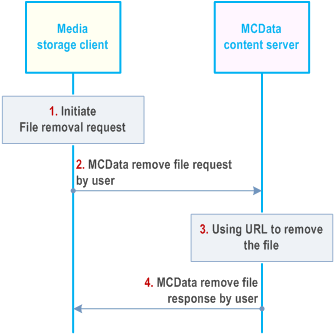
Step 1.
The user on the media storage client decides to remove a file that was previously uploaded.
Step 2.
The URL of the file to be removed is included in the request sent to the media storage function on the MCData content server.
Step 3.
The MCData content server remove the file indicated by the URL.
Step 4.
The MCData content server informs the media storage client if the file is successfully removed.
7.5.2.8.3 Procedure for interconnection between MCData systems p. 129
The procedure in Figure 7.5.2.8.3-1 describes the case where an MCData user removes the file that was previously uploaded to the primary MCData system MCData content server, and where the file has been made available in the partner MCData system MCData content server.
Pre-conditions:
- The MCData user on the media storage client is registered for receiving MCData service.
- The file has previously been uploaded to the MCData content server in the primary MCData system of MCData client 1.
- The file has been successfully transferred to the MCData content server in the partner MCData system.
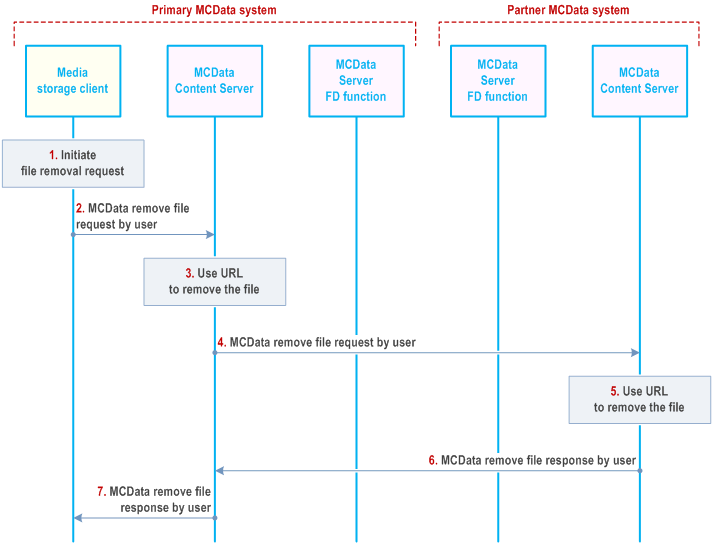
Step 1.
The user on the media storage client decides to remove a file that was previously uploaded.
Step 2.
The URL of the file to be removed is included in the request sent to the media storage function on the primary MCData content server.
Step 3.
The primary MCData content server removes the file indicated by the URL.
Step 4.
As the primary MCData content server has recorded that the file has previously been sent to the partner MCData system, the primary MCData content server sends the MCData remove file request to the partner MCData content server, containing the URL of the file which was stored on the primary MCData content server.
Step 5.
The partner MCData content server removes the file indicated by the URL.
Step 6.
The partner MCData content server informs the primary MCData content server that the file has been successfully removed.
Step 7.
The primary MCData content server informs the media storage client if the file is successfully removed.